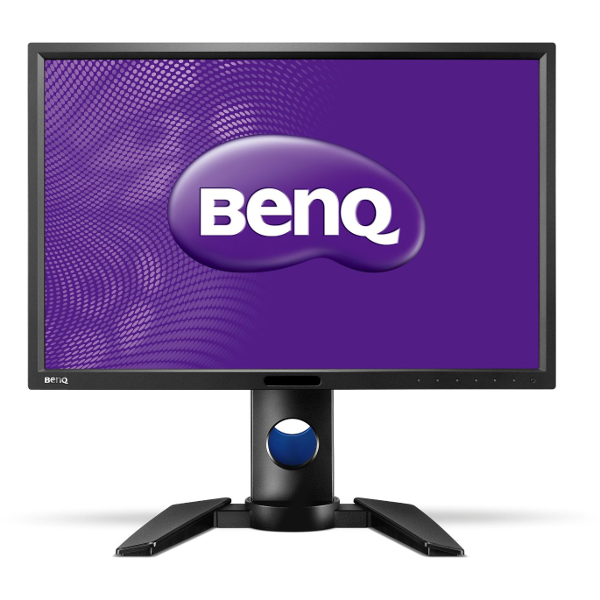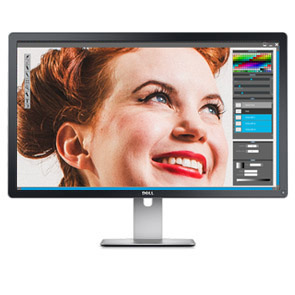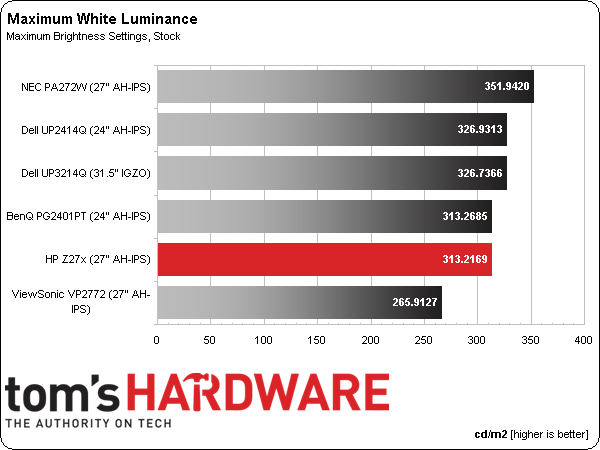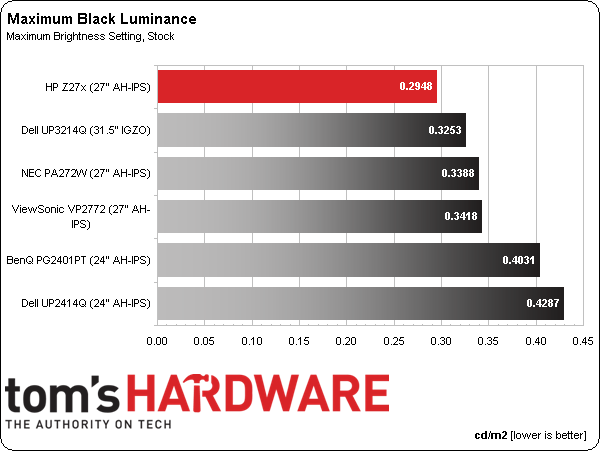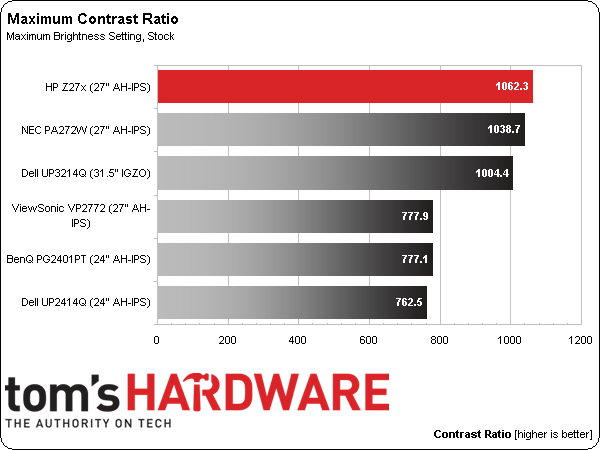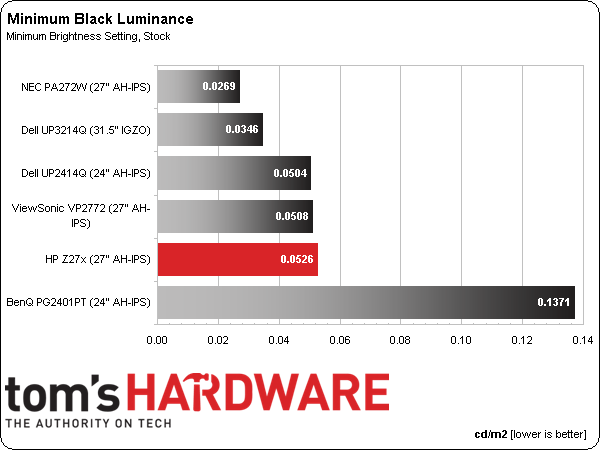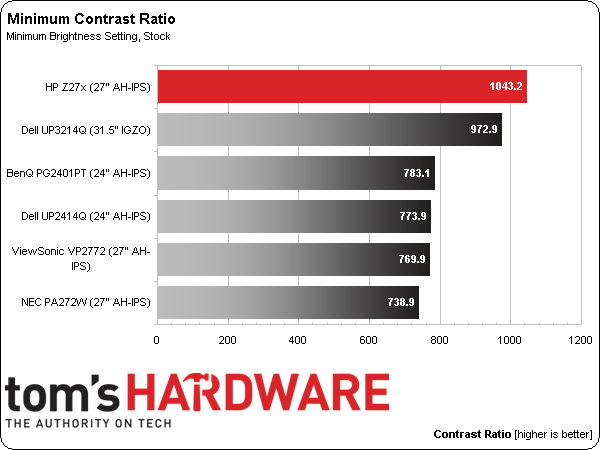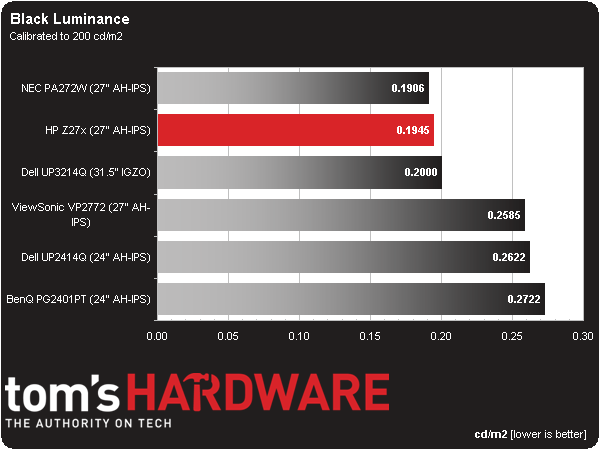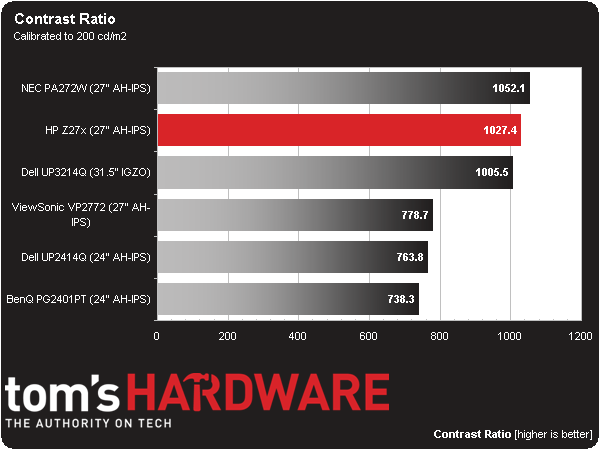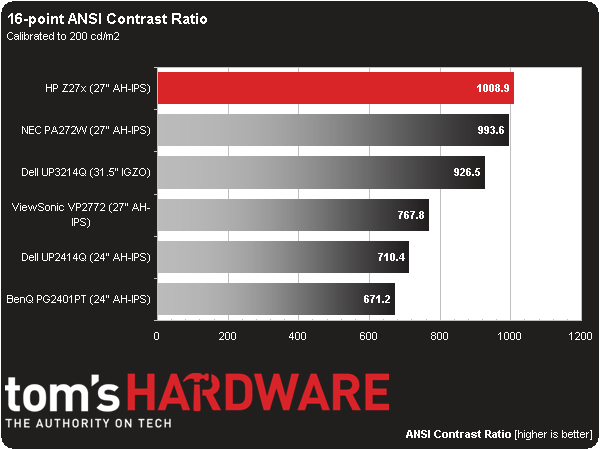HP Z27x Dreamcolor Professional Display Review
HP's new Z27x DreamColor supports all the important color gamuts and carries some distinctly unique features. This screen simply blows us away.
Why you can trust Tom's Hardware
Results: Brightness And Contrast
To read about our monitor tests in-depth, please read Display Testing Explained: How We Test Monitors and TVs. Brightness and Contrast testing is covered on page two.
Today’s comparison group consists of wide-gamut screens only. We have Dell’s two 4K models, the UP3214Q and UP2414Q; NEC’s excellent PA272W; Viewsonic’s VP2772; and BenQ’s PG2401PT. All of them are professional-grade products that come with a factory-documented calibration.
Uncalibrated: Maximum Backlight Level
HP rates the Z27x at 250 cd/m2 in its calibrated modes and we got readings around 260 cd/m2 in all of them. To reach the panel’s maximum output of 313.2169 cd/m2, you have to use the Native mode, though. Its color gamut is close to Adobe RGB anyway, so you could use the monitor that way if you needed it in a high ambient light situation like a location shoot. For the display’s intended use, however, 260 cd/m2 is more than enough brightness.
The maximum black level is quite respectable at .2948 cd/m2. While accuracy is the principle goal of this product, HP hasn’t forgotten the importance of a wide dynamic range and high contrast.
A measurement of 1062.3 to 1 is over our standard of 1000 to 1, making HP the top performer. It doesn’t get much better in the IPS computer monitor world. One hope we have for future improvement is VA technology, which more than doubled the above results when we tested BenQ's BL3200PT. Combining that level of contrast with the Z27x’s accuracy would make for a killer display.
Uncalibrated: Minimum Backlight Level
Dropping the Z27x’s backlight to its minimum setting yielded 54.8765 cd/m2 output. That's a great light level for working in the almost total darkness of a CGI artist’s editing station.
The top four screens all have correspondingly lower minimum white levels, so these results are no surprise. The PA272W bottoms out at a dim 19.8634 cd/m2; its minimum black level would be tough to work with.
Get Tom's Hardware's best news and in-depth reviews, straight to your inbox.
Ultimately, the greatest impact on image quality comes from contrast and the HP maintains its lead in our group of elite screens. Our hands-on use of the Z27x confirms that all kinds of content reap the benefit of its wide dynamic range. There is plenty of depth and dimension in whatever you’re looking at.
After Calibration to 200 cd/m2
Here’s what black levels and contrast look like after calibration with the max output set at 200 cd/m2:
We calibrated the Z27x using HP’s DreamColor solution, which is a modified i1Display colorimeter. The adjustments it made to the factory configuration were minimal, so the numbers are almost unchanged. The black level is still impressive, though.
NEC just edges out the Z27x, but the difference is small enough that you probably wouldn’t see it in a side-by-side comparison. Given the luminance results, we can say that HP boasts contrast performance better than almost all of its competitors.
ANSI Contrast Ratio
The Z27x regains its top spot. When the ANSI number is this close to the on/off value, we know the grid polarizer is of very high quality. HP’s custom part appears to improve contrast as well as off-axis image integrity.
Current page: Results: Brightness And Contrast
Prev Page OSD Setup And Calibration Of The HP Z27x Next Page Results: Grayscale Tracking And Gamma Response
Christian Eberle is a Contributing Editor for Tom's Hardware US. He's a veteran reviewer of A/V equipment, specializing in monitors. Christian began his obsession with tech when he built his first PC in 1991, a 286 running DOS 3.0 at a blazing 12MHz. In 2006, he undertook training from the Imaging Science Foundation in video calibration and testing and thus started a passion for precise imaging that persists to this day. He is also a professional musician with a degree from the New England Conservatory as a classical bassoonist which he used to good effect as a performer with the West Point Army Band from 1987 to 2013. He enjoys watching movies and listening to high-end audio in his custom-built home theater and can be seen riding trails near his home on a race-ready ICE VTX recumbent trike. Christian enjoys the endless summer in Florida where he lives with his wife and Chihuahua and plays with orchestras around the state.
-
DoDidDont I have 3x Z24x, very impressed with them so far for compositing and 3d work. Would have gone with 3x Z27x but simply don’t have the desk space or room for a bigger desk. My only worry is if they have the same problem as the older ZR24w’s they replaced, in that the whites go yellowish and make greys have a tint of brown after only one or two years of use. Always had a dark grey desktop, and in 3ds max everything is set to Dark GUI, and always been careful not to leave monitors on for long periods with the same image so no idea why the older ZR24w’s go yellowish after a while. Hopefully this problem has been fixed in the new line-up. But at the Mo, highly recommend these monitors, amazing quality for the price if you are into DCC.Reply -
laststop311 .29 is not a good black level really. Hopefully oleds will displace the need for these monitors soon, only a matter of timeReply -
somebodyspecial hopefully 1600p will displace 1440p soon ;) I'm tired of scrolling up/down so much on web pages. Gaming doesn't get any better wide either, and if I want that I'll use more than one monitor to get the best of both worlds (taller for the web, and wider for games if desired).Reply -
laststop311 Reply14215918 said:hopefully 1600p will displace 1440p soon ;) I'm tired of scrolling up/down so much on web pages. Gaming doesn't get any better wide either, and if I want that I'll use more than one monitor to get the best of both worlds (taller for the web, and wider for games if desired).
Agree 100% I had a 24" 1920x1080 Cheapo TN monitor and then I found a Dell u3014 on craigslist and jewed the guy down to 575 for it. The bezel was a little scuffed up but the screen was flawless was a hell of a deal and man once you are used to 16:10 you cant go back to 16:9 it feels claustrophobic.
I am not a graphics professional though. But I fear since 16:10 is more a professional monitor we will never see a gaming monitor with 120hz and g sync in 16:10. I just can't bring myself to downgrade to a 27" asus rog swift even tho i really could use the gaming features. I'm probably just going to hold onto this dell until 120hz 3840x2160 rog swift type monitor is released at 30-34 inches. I don't think there is much hope in 16:10 4k monitors, never seen one yet 3840 x 2400 i believe.
-
Draven35 When I was at HP in Fort Collins for the new Z Workstation launch, I had an opportunity (several opportunities, really) to chat with Greg Staten, the HP DreamColor Solution Architect. He's really enthusiastic about his work and was really excited that this review was coming!Reply -
rajubaju Complaints about lack of CMS in OSD... I couldn't agree with them more. Totally unacceptable... Especially when you know; z24x provides that possibility (like every other, wide gamut, monitor on the market; nec pa272w, dell u2713h, asus pa279q, vp2772, lg 27ea83-D etc.) In the z24x manual, we can read: "the User (User Preset) adjustable color settings for customers who do not have calibration equipment". What is the difference? with z27x - price i guess - you pay more, you get less! ;) I understand that now, when I buy z27x, I must buy a colorimeter (HP ofc)... even if I do not need ideal color accuracy... and i only want adjust monitor (RGB primaries) for my preferences. Not a chance! I hope that Greg Staten read this and add User preset, like in z24x, to Z27x... About saturation, 6 color adjustment, etc. I don't even dream; It would be a miracle! ;)Reply
